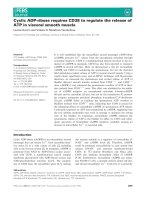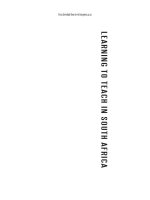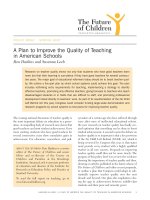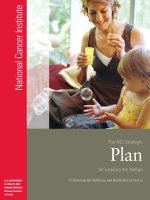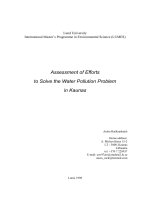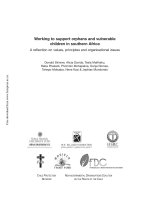Deepening Regional Integration to Eliminate the Fragmented Goods Market in Southern Africa docx
Bạn đang xem bản rút gọn của tài liệu. Xem và tải ngay bản đầy đủ của tài liệu tại đây (231.96 KB, 10 trang )
Deepening Regional
Integration to Eliminate the
Fragmented Goods Market
in Southern Africa
Ian Gillson
November, 2010
Introduction
This note summarizes new studies that
identify the most restrictive barriers to
regional goods trade in Southern Africa. It
also illustrates the costs associated with
these barriers using information gathered
from some of the largest firms engaged in
cross-border trade. The note concludes by
providing practical policy recommendations
to deepen regional integration in the goods
market and increase competitiveness.
A recent and important trend in global trade
has been the proliferation of regional trade
agreements (RTAs), and Southern Africa is
no exception. Regional integration efforts in
Southern Africa, such as COMESA, SADC
and SACU, have all sought to liberalize
trade between countries so as to increase
bilateral trade flows, diversify exports by
overcoming the limits of small markets, and
deepen specialization through achieving
economies of scale. Harnessing regional
integration more effectively, for both goods
and services, would help all countries lower
their cost base thereby enhancing global
competitiveness. For the smaller Southern
African countries, regional integration also
offers the prospect of improved access to
neighboring markets as well as the potential
to attract greater SADC-orientated FDI. In
some of these countries (e.g. Lesotho)
greater exploitation of the regional market is
critical to reduce reliance on exports of a
single product to a single market (e.g.
clothing to the United States under AGOA).
For the larger countries, especially South
Africa, regional integration offers
opportunities to enhance the sustainability of
existing exports (e.g. light manufacturing)
on world markets by lowering costs through
specialization within the context of
integrated regional value chains.
However, while Southern African countries
have largely succeeded in increasing their
trade with the rest of the world (more than
tripling in value between 2000 and 2008
from US$50 billion to US$153 billion),
increased regional trade has only played a
relatively small role. Opportunities for
export growth and diversification therefore
remain unexploited at the regional level.
While efforts to reduce tariffs have largely
Africa Trade Policy Notes
Note #9
been met with success, other forms of trade
restriction remain widespread. These
barriers affect considerably more than one-
fifth of regional goods trade, and are
hindering the competitiveness of domestic
firms and their ability to export to regional
and global markets, so must now be urgently
addressed.
Despite Southern African economies often
growing faster than the world average,
regional trade has remained relatively
constant
The share of intra-regional exports in SADC
has remained relatively steady at around 10
percent of total exports over the last decade
despite Southern African countries often
achieving higher annual GDP growth rates
than the world average over this period
(particularly 2003-2007). In contrast, the
most successful RTAs in Asia and Latin
America (e.g. ASEAN; MERCOSUR) have
reached and maintained relatively higher
degrees of regional trade (typically over 20
percent of their total trade), often through
intensified intra-industry linkages. While
SADC‟s merchandise exports to the world
as a proportion of its GDP have increased
dramatically, the share of exports to the
region have grown more slowly and account
for just 3 percent of GDP (see Figure 1).
Furthermore, traditional exports of
agricultural raw materials and minerals
continue to dominate regional trade in
Southern Africa. Cases of diversification
into higher value-added manufacturing
exports to the region remain limited e.g.
Mauritian clothing to South Africa, and
strong trade imbalances persist between
South Africa and the smaller countries.
Regional production chains, for exports to
the world market, remain virtually non-
existent.
The key policy issue for regional integration
in the Southern African goods market is why
these trade outcomes have been so limited
and what can be done to consolidate the
various RTAs to increase regional trade?
Figure 1: Regional trade has lagged behind
SADC income growth while exports to the
rest of the world have boomed
(1998-2008, annual values)
Sources: IMF Direction of Trade Statistics and IMF
Source: IMF Direction of Trade Statistics.
While efforts to reduce tariffs have
largely been met with success, other
barriers are critically hindering regional
trade
Regional integration efforts in Southern
Africa have made significant progress in
lowering tariff barriers to regional trade. For
example, SADC has been trading on
preferential terms since 2000 and, based on
the implementation of tariff phase down
commitments under the SADC Trade
Protocol, formally launched a free trade
area
1
(FTA) in August 2008. Under this,
85% of intra-SADC merchandise trade
flows are now duty-free with most of the
remaining 15% comprising sensitive
products
2
scheduled to be liberalized by
2012 (2015 for Mozambique). A sub-set of
five SADC members have already
established a customs union under SACU.
COMESA has also had an FTA since 2000.
Trade between FTA
3
and non-FTA
4
COMESA countries is conducted on
reciprocal terms under the Preferential Trade
Agreement.
The next step in COMESA‟s regional
integration agenda is the formation of a
customs union which was formally launched
in June 2009.
5
There are also a number of
1
The FTA is being implemented by Botswana,
Lesotho, Mauritius, Mozambique, Namibia, South
Africa, Swaziland, Tanzania, Zambia and Zimbabwe.
2
The remaining sensitive products mostly comprise
textiles and clothing, cotton, cereals, dairy and motor
vehicles.
3
Burundi (since 2005), Comoros, Djibouti, Egypt,
Kenya, Libya (since 2006), Madagascar, Malawi,
Mauritius, Rwanda (since 2005), Sudan, Zambia,
Zimbabwe.
4
DR Congo, Eritrea, Ethiopia, Seychelles,
Swaziland, Uganda.
5
After five years of negotiation, COMESA member
states agreed to a common external tariff in May
2007 with four bands for raw materials (0%), capital
goods (0%), intermediate goods (10%) and final
goods (25%) although, for some products,
discussions continue on which category they will be
bilateral trade agreements between Southern
African countries, most of which were
signed and implemented long before the
SADC and COMESA FTAs came into
effect.
The lesson from successful regional
integration experiences elsewhere in the
world is that tackling tariff barriers is not
enough to enhance trade. Countries must
also aim to facilitate regional trade by
addressing non-tariff barriers (NTBs), such
as restrictive product standards or complex
rules of origin. In the Southern African
context, borders remain thick as major
obstacles to regional trade remain. A
mapping of the various NTBs reported by
firms in SADC countries to trade flows in
the affected sectors shows that these barriers
impacted US$3.3 billion of regional trade in
2008, or one-fifth of regional exports (see
Table 1). In other words, even those barriers
which have been reported (and many others
may yet to be notified) are affecting
products in which there is already significant
regional trade. This is also a least cost
estimate of the impact of NTBs on trade in
the region since some barriers are so
restrictive that preferential trade is
effectively prohibited (e.g. wheat flour) and,
of course, others which affect all trade and
not just individual products (e.g. customs
delays, transport costs) which are not
captured here. So NTBs are widespread in
their effect on regional trade, even more so
than these figures suggest.
classified under. All tariff lines carrying a rate above
or below its common external tariff have been placed
on sensitive product lists, which should be adjusted to
the CET in a period of no more than five years.
Table 1: NTBs that have been notified to SADC affect at least one-fifth of regional trade
Source: Authors calculations based on NTBs reported to the SADC-EAC-COMESA Non-Tariff Barrier Monitoring
Mechanism.
The remaining barriers are also costly. On
average the tariff equivalent of NTBs is 40
percent, which for most products is much
higher than the MFN tariff applied by most
countries (Carrere and De Melo, 2009a, b).
Assuming 40 percent ad valorem
equivalence on those NTBs cited above,
which affect US$3.3 billion of Southern
African regional trade, would imply a crude
cost estimate of US$1.3 billion per year.
Consequently, NTBs significantly increase
costs both for firms that source intermediate
inputs from the region as well as for
consumers. For example, in SADC,
Woolworths reports that prices in its
franchise outlets in non-SACU SADC
countries are 1.8 times higher than those
within SACU because of higher
expenditures associated with sending goods
to these markets as well as the higher costs
of doing business in them.
What are the main types of barrier that
remain and how much do they cost?
There are, therefore, opportunities for
Southern African firms to trade across
regional borders which currently remain
unexploited due to policy constraints that
serve to raise trade costs. Five main types of
barrier can be broadly identified as follows:
Inefficiencies in transport, customs and
logistics raise trade costs: In order for
RTAs to be effective, it is critical that intra-
regional trade be able to move without
hindrance. Many Southern African countries
Barrier
Examples of products affected
Volume of intra-SADC trade
potentially affected
(% of total)
Import bans, quotas & levies
Wheat, beer, poultry, flour, meat, maize, UHT
milk, cement, sugar, eggs, pasta, sorghum,
pork, fruit & vegetables
6.1%
Preferences denied
Salt, fishmeal, pasta
0.4%
Import permits & levies
UHT milk, bread, eggs, sugar, fruit &
vegetables, livestock, liqour, cooking oils,
maize, oysters
5.4%
Single marketing channels
Wheat, meat, dairy, maize, tea & tobacco, sugar
5.3%
Rules of origin
Textiles & clothing, semi-trailers; palm oil;
soap; cake decorations; rice; curry powder;
wheat flour
3.0%
Export taxes
Dried beans, live animals, hides, skins, sugar,
tobacco, maize, meat, wood, coffee
4.8%
Standards/SPS/TBT
Milk, meat, canned tuna, beer, honey, maize
bran, cotton cake, poultry, batteries, sugar,
coffee, ostriches
2.5%
Customs-related
Wine, electronic equipment, copper
concentrate, salt, cosmetics, medicines
5.2%
are landlocked, making road and rail
networks very important in linking these
countries to both regional and global
markets. However, high transactions costs
are being incurred from inadequate transport
infrastructure, inefficiencies in customs
procedures (including delays at road checks,
borders and at ports) as well as poor quality
and costly logistics due to weak competition
among service providers. For example,
Shoprite reports that each day one of its
trucks is delayed at a border costs US$500
(Charalambides, 2010). And at Durban, the
Citrus Growers‟ Association in South Africa
estimates that delays there cost its growers
US$10.5 million per season (on
approximately US$400 million of exports).
A related source of delay within the region
concerns work permit regimes for foreign
truck drivers. In South Africa, visitor visas
used to be accepted for this purpose but
foreign drivers will soon be required to
obtain work permits. This necessitates
companies proving that the skills being
sought outside of South Africa are not
available domestically and involves each
post being advertised locally. There are
between 1,600 and 2,000 foreign drivers in
South Africa who will require these permits,
affecting 6,000-8,000 deliveries per month.
While ostensibly designed to protect
employment opportunities, the new
approach does not take into account
prospects for South African drivers
operating in regional markets and may
hamper regional integration. In particular, it
risks South Africa‟s neighbors reciprocating
with similar measures that will force South
African drivers working in these countries to
also apply for work permits. For example,
Angola has already signaled its intention to
put in place a similar requirement for South
African drivers crossing its border. Such
restrictions could significantly impede the
movement of trucks in and out of countries
and make trade even more difficult for
regional exporters than it is now.
Cumbersome fiscal arrangements
necessitate borders: Fiscal borders between
Southern African countries are unnecessarily
complicated and inefficient and contribute to
higher trade costs. The three main reasons
SACU retains internal border posts, even
though it is a customs union, are to capture
data on intra-SACU trade for revenue
sharing purposes; administer NTBs e.g.
infant industry protection; and, because
domestic sales taxes have not yet been
harmonized, requiring refunds and
payments. The costs and delays associated
with these procedures reduce trade flows
between Southern African countries. Those
costs attributable to the differences in VAT
alone have been estimated to be up to 2
percent of the value of each transaction on
intra-SACU trade (Jitsing and Stern, 2008).
Restrictive rules of origin limit preferential
trade: Onerous local content requirements in
rules of origin (ROOs), particularly in labor
intensive sectors (e.g. clothing) that use
capital intensive inputs not produced
competitively in the region (e.g. fabrics),
and high compliance costs with
administering certificates of origin reduce
the utilization of tariff preferences offered
by RTAs and therefore the incentive for
Southern African firms to trade regionally.
A recent example of the costs associated
with meeting ROOs involves SACU moving
to more restrictive rules (double
transformation) on selected clothing imports
from Malawi, Mozambique, Tanzania and
Zambia following the expiration of the
MMTZ-SACU Market Access Arrangement
at the beginning of 2010. This has resulted
in some clothing producers in these
countries (e.g. Bidserv in Malawi) being no
longer able to compete in the regional
market. It has also further distorted
investment decisions as some of these firms
have relocated to the BLNS countries as a
result of the change to avoid the loss of
preferences in supplying the South African
clothing market. For other products where
ROOs have been so contentious (e.g. wheat
flour) or simply not agreed (e.g. certain
electrical products for which rules were only
finalized in April 2010), preferential trade
within the region has been effectively
prohibited (Naumann, 2008). Further costs
arise from the administrative requirements
for certificates of origin which can account
for nearly half the value of the duty
preference. For example, Shoprite spends
US$5.8 million per year in dealing with red
tape (e.g. filing certificates; obtaining import
permits) to secure US$13.6 million in duty
savings under SADC. Woolworths does not
use SADC preferences at all in sending
regionally-produced consignments of food
and clothing to its franchise stores in non-
SACU SADC markets. Instead it simply
pays full tariffs because it currently deems
the process of administering ROO
documentation to be too costly!
Poorly designed technical regulations and
standards limit consumer choice and
hamper trade: Standards regimes in
Southern Africa are often characterized by
an over-reliance on mandatory inspections
and certifications; unique national (rather
than regional or international) standards and
testing; overlapping responsibilities for
regulation; and, occasional heavy
government involvement in all dimensions
of the standards system. These factors
create unnecessary barriers to trade,
especially when technical regulations and
standards are applied in a discriminatory
fashion against imports. International best
practice is to use technical regulations only
to ensure core public policy objectives such
as maintaining safety. Voluntary standards
should be used in all other cases, including
indicating quality attributes. But in several
Southern African countries, scarce public
resources are being wasted on developing
and enforcing technical regulations that go
well beyond issues of purely public interest.
One example is shoes in Mauritius where
the Chamber of Commerce has proposed the
development of a regulation to govern their
quality to prevent the entry of low-cost
Chinese sandals that are perceived to have a
tendency to wear more quickly than
domestically-produced ones. However, these
are often the only shoes that the poorest
people in Mauritius can afford to buy.
Similarly, in most Southern African
countries there are also no procedures by
which technical regulations are assessed in
terms of their consistency with public policy
objectives; whether countries and the private
sector have the capacity to implement them;
or, their impact on trade and
competitiveness. The main objective,
therefore, should be to make regulations
more efficient at achieving public policy
objectives while minimizing their impact on
trade. In particular, no „Office of Regulatory
Reform‟ exists in any Southern African
country to review the justification for both
new and existing technical regulations. This
absence of regulatory impact assessment
causes problems and raises costs. For
instance, the environmental levy on plastic
bags in South Africa was introduced to
reduce problems associated with litter, but
the technical regulation governing it also
affects unrelated issues such as the
minimum thickness of the plastic to be used
as well as the size of the text that could be
printed on the bags. While regional efforts to
harmonize standards in SADC are under
way (i.e. SADCSTAN), application remains
lacking. Only Namibia and Swaziland have
adopted all 78 (to date) of the SADC-
defined harmonized standards for the region,
of which some have been developed without
any real sense of prioritization and so are
unlikely to bring significant increases in
regional trade (e.g. frozen peas and dried
apricots).
Other non-tariff barriers restrict
opportunities for regional sourcing: Other
barriers such as trade permits, export taxes,
import licenses and bans also persist.
Shoprite, for example, spends US$20,000
per week on securing import permits to
distribute meat, milk and plant-based goods
to its stores in Zambia alone. For all
countries it operates in, approximately 100
(single entry) import permits are applied for
every week; this can rise up to 300 per week
in peak periods. As a result of these and
other documentary requirements (e.g.
ROOs) there can be up to 1,600 documents
accompanying each truck Shoprite sends
with a load that crosses a SADC border.
Lack of coordination across government
ministries and regulatory authorities also
causes significant delays, particularly in
authorizing trade for new products. Another
South African retailer took three years to get
permission to export processed beef and
pork from South Africa to Zambia.
In SACU, national protection for infant
industries has often been used to justify
import bans. Namibia has used the provision
to protect a pasta manufacturer and broilers
and maintains protection on UHT milk even
though its eight year limit to do this recently
expired. Botswana has recently limited
imports of specific varieties of tomatoes and
UHT milk. Seasonal import restrictions on
maize, wheat and flour also ensure that
domestic production is consumed first. For
example, Swaziland‟s imports of wheat flour
were effectively prohibited for half of 2009
since no import permits were issued since
June of that year. Export taxes also impose
costs and inhibit the development of
regional supply chains. A case in point is
small stock exports from Namibia. Since
2004 the Namibian Government has limited
exports to encourage local slaughtering.
Quantity restrictions were originally used
but have recently been replaced by a flexible
levy of between 15-30 percent, effectively
closing the border for the export of live
sheep to South Africa. The impact of this
restriction is affecting the small stock
industry in both Namibia and South Africa.
In the former, exports of live sheep declined
by 84 percent between 2004 and 2008 as
farmers have switched to alternative
activities like cattle and game farming. For
those sheep farmers that remain, they have
become almost entirely dependent on the
four Namibian export abattoirs while they
were previously able to sell more sheep to
the South African market where they
received higher prices (PWC, 2007). There
have also been cases of livestock smuggling
to avoid the tax. In South Africa, 975 full-
time jobs are at risk because of the scheme,
especially in the bigger abattoirs in the
Northern and Western Cape that focus on
slaughtering Namibian sheep during the low
season to better utilize their capacity
(Talijaard et al., 2009).
The implication of the current system and
the barriers remaining to regional trade in
Southern Africa is that it imposes
unnecessary costs for producers that limit
trade and raise prices for consumers. Many
of these barriers are simply wasteful and do
not serve any real purpose. Import bans and
delays create uncertainty over market access
and limit investment. Thick and fragmented
borders limit possibilities for regional
production chains in which countries can
exploit their comparative advantage in
specific tasks and intra-industry trade.
Finally, the heavy bureaucratic burden
imposed on all regional trade flows ties up
regulatory and customs resources, limiting
their attention on achieving the most
pressing public policy objectives such as
effective border management to ensure
security. Instead of scrutinizing all
consignments, border checks should be
focused on those for which the risks are
greatest for circumventing national trade
policy measures.
Priorities for regional merchandise trade
reform and implementing them
There are, therefore, a wide range of barriers
that persist on regional merchandise trade in
Southern Africa. Which among these are the
most pressing in terms of their restrictive
effect, or perhaps easiest to deal with, that
should be prioritized and tackled early on by
policymakers?
First, one of the biggest issues for regional
trade integration in Southern Africa,
especially for manufactures and agro-
processed products, is undoubtedly ROOs.
The issue has gained particular prominence
in light of the planned Africa-wide Tripartite
FTA where one set of rules for all countries
will have to be agreed. This is generally
accepted by all member states in SADC,
COMESA and EAC. Harmonization of the
different rules among the regional groups
will not be possible for all products because
process requirements, employed for example
under SADC, cannot be easily harmonized
with the value addition criteria under, for
example, COMESA. So a new set of ROOs
will need to be agreed, either based on one
of the existing arrangements or completely
redesigned. Characteristics of ROOs that
would encourage the development of new
export industries would include:
Providing exporters with a choice as to
which rule (defined simply and
transparently) they apply e.g. either a
change in tariff heading test (ideally at a
disaggregated product level) or a
reasonable value-added rule (20
percent);
eliminating process-specific ROOs
which set out how a product is to be
made for originating status to be
conferred;
removing the requirement for certificates
of origin for products with nuisance
tariffs i.e. those with preference margins
below three percentage points;
enforcing these simplified rules more
consistently and effectively at customs
to mitigate any concerns over leakage or
trade deflection; and,
greater use of risk assessment, especially
for large, trusted regional traders who
should not require a certificate of origin
for each consignment but, instead,
should be able to submit these
electronically per batch.
Secondly, resolving the other types of
NTBs, both existing and curtailing the
development of new ones, is also vital as
these are also critically restricting trade in
the region particularly for primary
agricultural commodities. Among these, the
most serious barriers are import bans,
quotas, permits and licensing, often
implemented by countries with little or no
consultation with their trading partners. In
dealing with these types of restrictions, the
existing framework to remove NTBs in the
region (the non-tariff barrier monitoring
mechanism) is not used as much as it should
be. The use of regulatory impact assessment
should also be extended.
Thirdly, while tariffs have been reduced
across the region barriers arise in those
sectors where tariff peaks persist. One
advantage with addressing remaining tariffs
is that tariff reform can often be dealt with
by “a stroke of the pen” approach, as
opposed to some of the other barriers where
reform will be complex, perhaps more costly
and certainly more involved. High tariffs
are especially restrictive because concerns
of leakage from third countries can create
the need for additional barriers at the
regional level (e.g. ROOs) as well as
affecting regional trade in all sectors as
border checks are intensified to check for
transshipments of these products. Lower,
more uniform, external tariffs would
significantly reduce the need for many of the
barriers which persist on regional trade in
Southern Africa as would the development
of policies that directly address the
difficulties that protected sectors may be
facing such as assisting labor in these
industries to retrain in tasks where
employment opportunities are much better.
Fourthly, reducing bureaucratic
requirements, streamlining border
management procedures and implementing
trade facilitation measures, including one-
stop border posts (OSBPs), have significant
potential to lower border crossing times and
reduce transport costs, at least along the
main corridors in Southern Africa. There is
also increasing political willingness among
the member states for this type of reform to
go ahead sooner rather than later. For
example, the South African Government has
recently identified OSBPs as one focus area
it wishes to develop for regional integration
in the next twelve months. However revenue
concerns among the smaller SACU
countries risk impeding reform. Overcoming
this challenge will require the development
of better ways to capture trade flows across
SACU borders than those currently
employed as well as an open discussion
about alternatives to the current revenue
sharing arrangement that might be more
effective and sustainable in the long-term.
In which areas of trade reform would
regional approaches be most appropriate?
One reason RTAs have become so prolific
has been due to their convenience in dealing
with more complex and modern trade
barriers (e.g. NTBs) in a simpler setting
involving fewer countries. Another
argument is that adjustment costs of trade
reforms may be easier to deal with by
opening up to a subset of countries initially
before to all later on. In other words,
regional trade reform can be used
strategically to support unilateral trade
reform that might otherwise be too difficult
on the grounds of adjustment.
Nevertheless, not all reforms need wait for
regional agreement either and much can be
done both unilaterally and bilaterally to
increase regional trade. For example,
regional harmonization is just one way to
deal with restrictive product standards.
Countries retain significant scope to
unilaterally improve both the quality of their
technical regulations and the way these are
applied. Another example is trade
facilitation which can be, and is being,
promoted at the regional level in SADC but
countries can still push ahead with reforms
bilaterally to increase cooperation and share
customs facilities at their borders. Some
reforms may even be best tackled outside
the regional process. Cooperation on indirect
taxes might be more feasible bilaterally
instead of regionally. And the issue of tariff
peaks must be dealt with unilaterally,
particularly by South Africa which under the
current SACU arrangement is able to export
a diverse range of goods to SADC but
behind high and complex external barriers to
trade which are costly to consumers and
producers in neighboring countries alike.
About the Author
Ian Gillson is an Economist in the Africa
Region of the World Bank. This work was
part-funded by the Multi-Donor Trust Fund
for Trade and Development supported by the
governments of Finland, Sweden, Norway,
the United Kingdom, and the Bank
Netherlands Partnership Program (BNPP).
The views expressed in this paper reflect
solely those of the author and not
necessarily the views of the funders, the
World Bank Group or its Executive
Directors.
References
Carrere, C. and De Melo, J. (2009a), „Notes
on detecting the effects of Non Tariff
Measures‟, CERDI working document E
2009.32.
Carrere, C. and De Melo, J. (2009b), „Non
Tariff Measures: What do we know? What
should be done?‟, CERDI working
document E 2009.33.
Charalambides, N. (2010)‟, Addressing
NTBs in regional goods trade in Southern
African countries‟, Sustainable Commerce
Consulting, Gaborone.
Jitsing, A. and M. Stern (2008), „VAT
practices within SACU and possibilities for
harmonisation‟, Southern African Regional
Integration Project, World Bank.
Naumann, E. (2008), „Intra-SADC and
SADC-EU rules of origin – reflections on
recent developments and prospects for
change‟, TRALAC.
PWC (2007), „Evaluation of the
implementation of the Small Stock
Marketing Scheme in relation to the
Namibian Government‟s value addition
goals and objectives‟, Windhoek.
Talijaard, P., Z Alemu, A. Joote, H. Jordaan
and L. Botha (2009), „The impact of
Namibian Small Stock Marketing Scheme
on South Africa‟, National Agricultural
Marketing Council, South Africa.

